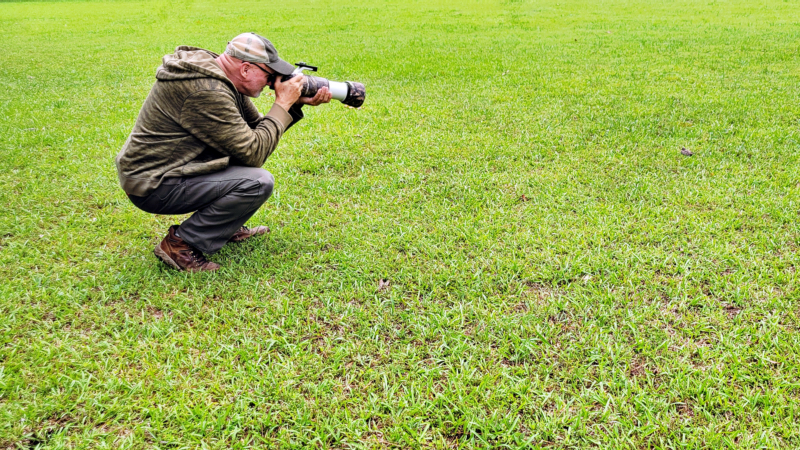While walking through my yard in Arkansas after a light rain, I spotted a young Mourning Dove resting quietly among the damp grass. Its soft, scruffy feathers and still posture blended almost perfectly into the greenery.

Mourning Doves are common across much of North America. This one appeared to be a fledgling, easily identified by its juvenile plumage and slightly shorter tail feathers. It looked like it might have been waiting for a parent nearby or simply resting after a flight.
The scene was calm, and the soft overcast light helped bring out the feather detail and earthy tones. I stayed at a respectful distance to avoid disturbing the bird, using my telephoto lens to get close without getting too close.
Identifying a Mourning Dove Fledgling
Juvenile Mourning Doves often look slightly different from adults. Their feathers are duller, with a bit more texture and less sheen. The tail feathers, which are long and pointed in adults, appear shorter and more squared in fledglings. They also tend to be more grounded, staying low and still while waiting for feeding or guidance from a parent.
For more observations and photos, take a look at another post I wrote about a Mourning Dove fledgling in my yard.
Mourning Doves in My Yard
I frequently see Mourning Doves here, but fledglings like this are a rarer sight. Their quiet behavior and natural camouflage can make them hard to spot. This encounter was a nice reminder to always walk slowly and observe carefully, especially during breeding season.

Camera Settings for This Shot
I used my Canon EOS R5 Mark II with the RF 100-500mm F4.5-7.1 L IS USM lens. The light was soft from a recent rain, and I took advantage of that natural diffusion to highlight the subtle textures in the bird’s feathers.
Camera Settings:
Camera: Canon EOS R5 Mark II
Lens: RF 100-500mm F4.5-7.1 L IS USM
Aperture: ƒ/8
Focal Length: 500.0 mm
Shutter Speed: 1/2000
ISO: 3200
Exposure Mode: Manual
Exposure Compensation: +1/2
FAQ
What do juvenile Mourning Doves look like?
Juvenile Mourning Doves have duller plumage, shorter tail feathers, and a slightly scruffy appearance compared to adults.
How long do Mourning Dove fledglings stay with their parents?
Fledglings usually stay with their parents for about two weeks after leaving the nest, during which time they learn to forage and fly.
Are Mourning Doves common in backyards?
Yes, Mourning Doves are one of the most widespread and familiar birds in North America, often seen in yards, fields, and open woods.
How can I help Mourning Doves in my yard?
Providing open ground for foraging and a clean water source can help. Avoid using pesticides and keep pets away from ground-roosting birds.
What time of year do Mourning Doves nest?
They typically nest from spring through early fall, with some pairs raising multiple broods in a season.
